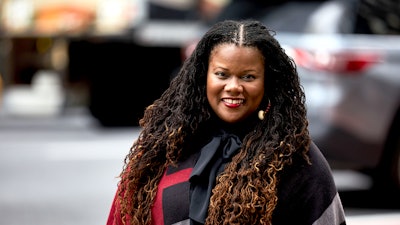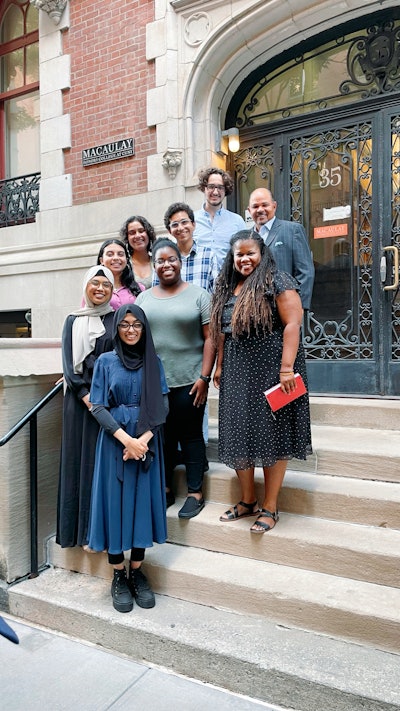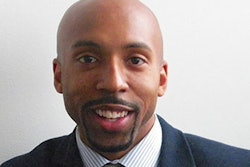 Dr. Dara N. ByrnePHOTO COURTESY OF CUNY
Dr. Dara N. ByrnePHOTO COURTESY OF CUNY
“Macaulay can provide an elite education — or a model that exemplifies the best of what higher ed has to offer — but without elitist recruitment or admissions processes,” says Byrne, who has been a faculty member at John Jay College of Criminal Justice (part of CUNY) since 2003. From December 2016 to July 2022, when she left to begin her new position, she served as associate provost for undergraduate retention and dean of undergraduate studies. She oversaw 15 departments and was responsible for the academic success of John Jay’s 13,000 undergraduates.
“There is so much talent and we can’t afford to waste it by using methods and measures that don’t align with what we know about cultivating and nurturing future scholars and leaders,” she adds. “Justice and equity are driving forces in most everything I do.”
Macaulay is a highly selective honors college for students in the CUNY system. Less than 10% of applicants are accepted. Those New York residents who make it receive full-tuition scholarships or tuition waivers (for individuals from out of state). Students enroll in one of eight senior CUNY colleges, taking most courses at their home campuses where they have access to the campus honors lounge. Each scholar receives financial support for study abroad and specialized advisors through the Macaulay Advising Program.
“I hope that in occupying this kind of role and doing things the way that I like to do them — rigorous, evidence-based, at scale — we can really contribute to a very important piece of the conversation, which is how do you do selectivity with a CUNY mission in mind,” says Byrne.
Her goal is to provide an elite education without elitist practices that exclude communities of color and low-income people. This includes scaling up the best of what public education has to offer while eschewing elitist admissions practices that don’t allow for talent identification in diverse context.
“[Macaulay] graduation rates are double that of the rest of the system,” Byrne says. “The racial gap in graduation rates is minimal. They focus on experiential learning in New York City, mentoring and research support for students. To do that with a population that is increasingly coming from the lowest income brackets is exciting to me.
“Strengthening and elevating that and becoming a national model so that other selective schools…can look to what CUNY and Macaulay are doing [is] an important touch point,” she continues.
 Students meet with Macaulay Honors College Dean Dara N. Byrne and CUNY Executive Vice Chancellor and Chief Operating Officer Hector Batista.Photo Credit: Macaulay Honors College
Students meet with Macaulay Honors College Dean Dara N. Byrne and CUNY Executive Vice Chancellor and Chief Operating Officer Hector Batista.Photo Credit: Macaulay Honors College
Access to higher education has been an important theme in Byrne’s life in academia. She was born in Guyana and moved with her family to Trinidad and then to Canada. As an English major and later graduate student pursuing her master’s at Carleton University in Ottawa, Byrne examined the work of Black authors, writing a thesis about Toni Morrison, but was frustrated by the lack of Black faculty or even readily accessible diverse materials.
That led Byrne to pursue her doctorate at Howard University. Working as a teaching assistant for two freshman courses sparked her desire to teach, and Howard’s change-oriented mission impacted her vision of making higher education more equitable.
Upon completion of her Ph.D. in rhetoric and intercultural communication, she earned a Rockefeller Foundation fellowship in the Institute for Research on the African Diaspora in the Americas and the Caribbean at the CUNY Graduate Center. She concluded the fellowship and joined the faculty of John Jay. After earning tenure, Byrne began taking on administrative roles, one which notably put her in direct contact with Macaulay Honors College. She was integral in launching Macaulay at John Jay in 2012, serving three years as the program director.
“Through that opportunity, I really got to see what it was like to personalize a CUNY experience for these students,” she says. “So, they get to feel like they’re in a small college in the middle of an enormous university system. And what they’re doing is designed especially for them. It’s extraordinary to see what students can do when you remove the barriers and put resources towards getting them out there in the world.”
At John Jay, Byrne helped implement programs that dramatically increased graduation rates. She speaks proudly of CUSP (Completion for Upper-division Students Program), which uses predictive analytics to identify students at risk of not graduating because they have depleted their financial aid. In its first three years, about 600 more students earned degrees. During her time in administration, John Jay’s graduation rate rose from 24% to 41%.
Byrne also oversaw the STEM Acceleration Program for freshmen, funded by Bank of New York Mellon, for students behind in their credit accumulation in year one. She was crucial to building smooth transfer pathways from CUNY’s community colleges to John Jay.
Byrne is intent on increasing Macaulay’s already high graduation rate of approximately 80%, which continues to rise even as the number of Pell Grant recipients has risen. She describes this as a college that supports students where they are and takes them where they want to go.
There is also an effort to increase equity. From its inception, Macaulay Honors College only accepted applications from high school seniors and has not accepted transfer students. The Macaulay Bridge Scholars program created a pathway to honors education for CUNY community college students. Launched as a pilot program in 2017, Byrne is working to find funding to scale the program to a more substantial size.
Looking to the future
“We had these pockets of cohorts that through philanthropic support are 20 at a time moving to a senior college,” Byrne says. “I’m using that data and information about what we’re learning in order to think about what a fully funded partnership model looks like because it’s not exactly the same as what it looks like for students who enter straight out of high school.”
The program cannot be designed like a traditional transfer program, Byrne notes, because this needs to be structured so that these students are not at a disadvantage in terms of social capital when they start their junior year. The current cohorts do take specific seminars, but Byrne wants experiential learning added. That will only be possible through additional philanthropic partners, which she is working to cultivate so the program can come out of pilot mode and be institutionalized.
“One of the things about being a nontraditional college leader is that it is just as challenging for me to meet people and make phone calls to the change-makers in any field, just like what our students experience,” Byrne says. “I’m always interested in how to make connections with some of these foundation partners.
“Given the promise of what we are trying to do, it does take stakeholders — people who believe in this idea,” she continues. “More and more in higher ed, people are very interested in what it means to support the whole student and to engage with anti-racist practices.”
Byrne suggests that undergraduate and graduate students who want to study issues of race, racism, and representation but may not be at an institution that offers such courses network nationally and internationally via the internet. There are groups on social media that are building communities, including informal mentoring networks and conversations for people of color.
“There is the pooling of knowledge,” she says. “It’s an incredible way to think about what is happening in the underground. [People] have built lots of tunnels, pathways, bridges, and connecting points... regardless of where you are, you will be able to find a community that’s right for you."
Byrne says students she worked with at John Jay, and now at Macaulay, have no intention of being in classroom spaces that diminish their political identities, their search for justice, and their commitments to change.
“Being in an urban environment to teach is an extraordinary opportunity to co-create with students that are earnest in their desire to do something better than what was done before,” Byrne says. “What they’re not looking for is the kind of curriculum and teaching approaches where they’re left on the outside or they’re meant to just absorb without being full participants.”















